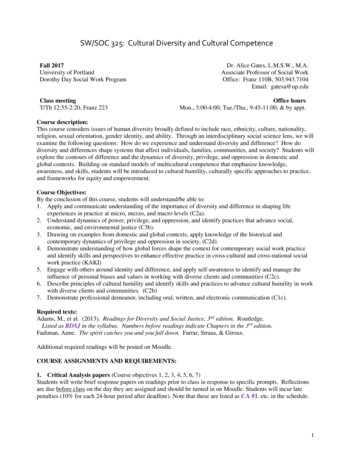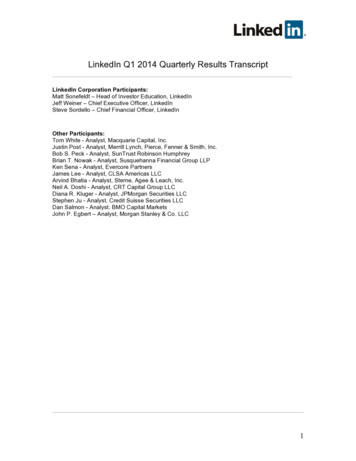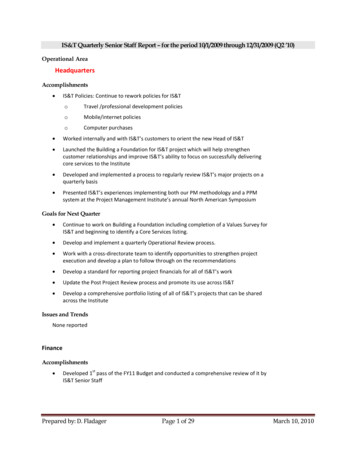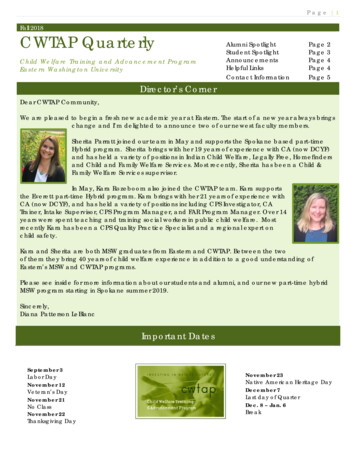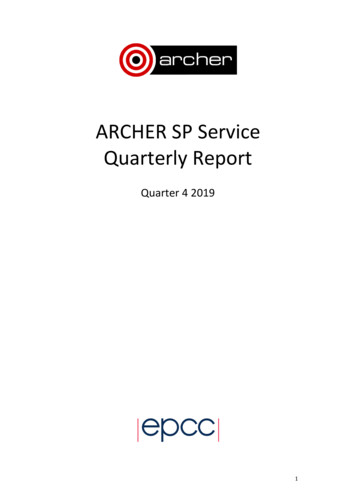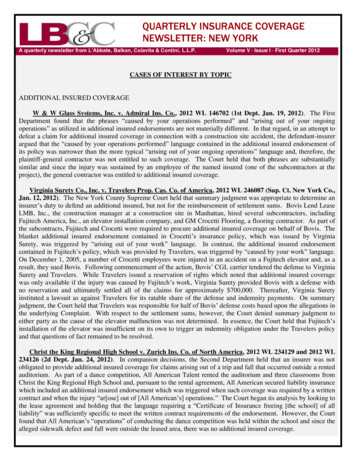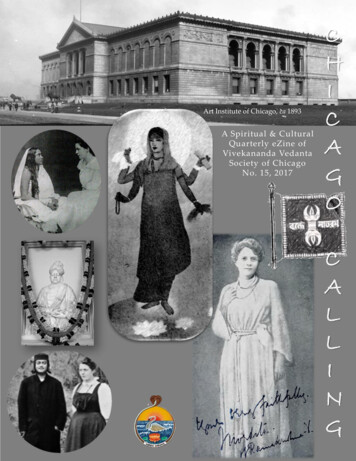
Transcription
Art Institute of Chicago, ca 1893A Spiritual & CulturalQuarterly eZine ofVivekananda VedantaSociety of ChicagoNo. 15, 2017CHICAGOCALLING
Table of ContentsPageEDITORIAL3MARGARET NOBLE: THE SPIRITUAL DAUGHTEROF SWAMI VIVEKANANDA4SWAMI KRIPAMAYANANDASISTER NIVEDITA’S CONTRIBUTION TO INDIANWOMEN’S EDUCATION8SWAMI SUNIRMALANANDASISTER NIVEDITA: A PERSPECTIVE OF ANAFRICAN-AMERICAN WOMAN14OCTAVIA HARRISTONTRIBUTE TO SISTER NIVEDITA21RUNA BHAUMIKARISE, AWAKE AND STOP NOT23SISTER NIVEDITA AND HER TIMES24SWAMI ISHATMANANDAINTRODUCTION TO THE COVER PAGE28ADVERTISEMENTS32Editor: Swami IshatmanandaVivekananda Vedanta Society of Chicago14630 Lemont Road, Homer Glen. 60491email: ezine@chicagovedanta.orgchicagovedanta.org Copyright:Swami-in-ChargeVivekananda Vedanta Society of ChicagoNO 15. 2017Chicago Calling2
EditorialMs. Margaret Elizabeth Noble, Sister Nivedita, isself-sacrifice. Sacrifice of those who were known forthe embodiment of Vedic dictum, Tyage Naikethose who were unknown. It was truly a heroicAmrithatwa Manasu, Eternal bliss cannot bedecision for an educated young lady of 30 years old.achieved without renunciation.Margaret Elizabeth Noble had great faithSri Shankaracharya said that it is only by God’s(shraddha) in the words of her guru, Swamigrace that three things can be achieved by a human.Vivekananda, and equal faith (confidence) in herThey are human birth (manusatwam), the desire forown capacity.liberation (mumukshatwam), and finally theShe left behind her motherland, family andguidance of a godly person (Mahapurushafriends and reached the land of her dreams, India, onSamshraya).28th January 1898.Margaret Elizabeth Noble, the daughter ofTwo great incidents happened in her life:Samuel Richmond Noble and Mary Isabel Noble ofFirst, meeting Sri Ma Sarada Devi and becomingNorthern Ireland, got all three. She was a blessedher baby daughter (Khuki). Mother’s personality,soul.purity, simplicity and unfathomable spiritualThe influence of her father helped her to developknowledge sanctified the heart of Margaret.truthfulness, religious zeal, love and service to theSecond, entering the life of all-renouncers. Swamipoor and downtrodden. And, by the grace of God,Vivekananda gave Margaret ‘Brahmacharya’ andshe received the blessings of the greatest spiritualgave her the name ‘Nivedita’, the ‘dedicated one’soul—Swami Vivekananda.and blessed her to move like Buddha in the world ofMargaret became successful in her external life,misery and affliction giving service and love.but her church-regulated religious life could not giveNivedita followed the instructions of her greather peace. She was restless to know the truth, toguru without caring for her personal safety orknow what God is, to know how to realize God! Hercomfort.intense longing to know God (mumukshuta) broughtIn the year 1899, just a year after her arrival inher into the holy company of a Mahapurusha—Calcutta, a great plague broke out. SwamiSwami Vivekananda.Vivekananda, the propounder of Vedanta in PracticeIt was on a cold afternoon in November 1895 ingave a call to serve the ‘living gods’, the plagueLondon that Margaret met her guru, Swamiinfected people of the city.Vivekananda, for the first time.A famous personality, Dr. R. G. Kar, recorded:The Swami was explaining Vedanta philosophy,“During this calamity the compassionate figure ofand his words charmed Margaret. She attendedSister Nivedita was seen in every slum of theseveral other lectures and question-answer sessionsBagbazar locality. She helped others with moneyof the Swamiji.without giving a thought to her own condition. AtAt last Margaret realized that this Indianone time her diet consisted of only milk and fruits.Sannyasin would be able to lead her to the truth sheShe then even gave up milk to meet the medicalhad been searching for. Margaret accepted Swamiexpenses of a patient. Having discussed with her theVivekananda as her Guru. And, Swamiji also becamepossibilities of hygienic nursing in the slums of theconvinced of Margaret’s truthfulness, determinationpoor people I asked her to take precautions. When Iand kindness.went to visit the patient again in the afternoon I sawSwami Vivekananda through his divineSister Nivedita sitting with the child on her lap in thefarsightedness saw that Margaret would be a perfectdamp and weather beaten hut in that unhealthyinstrument in his mission of applied Vedanta, i.e.,locality. Day in and day out, night after night, she“Service to Man is Service to God.”remained engaged in nursing the child in that hut,Swamiji wrote to her: “Let me tell you franklyhaving abandoned her own house. When the hutthat I am now convinced that you have a great futurewas to be disinfected she took a small ladder andin the work for India. What was wanted was not abegan white washing the walls herself. Her nursingman but a woman—a real lioness—to work fornever slackened even when death was a certainty.Indians, women especially .your education,While nursing the sick child not a shade of bitternesssincerity, purity, immense love, determination, andmarked the corner of her face, not a murmur of selfabove all, the Celtic blood make you just the womanpity crept into the words she used.”wanted.”It was not an ordinary call—it was the call forNivedita gave her all and became immortal.NO 15. 2017Chicago Calling3
MARGARET NOBLE: SPIRITUAL DAUGHTER OFSWAMI VIVEKANANDASWAMI KRIPAMAYANANDAHead, Vedanta Society of TorontoThis article is based on the lecture delivered at the 150th Birth Anniversary on May 21, 2017Today is the first day of the series of talks thatwill be delivered by visiting swamis every monthat the Hindu Temple of greater Chicago in Lemont.The first talk is on “Margaret Elizabeth Noble: TheSpiritual Daughter of Swami Vivekananda.” Weknow about the birth and childhood of SisterNivedita—Margaret Elizabeth Noble. She was abrilliant student. She finished her education at theage of 17 and started teaching at that young age.After a few years she started her own educationalinstitute. She was quite famous for her noble ideasabout how to teach children, and she was by herown right a unique teacher and educationalist. Shewas a writer, an orator, and had earned quite aname in England.In 1898 she heard that a monk from India wasvisiting England. He was meeting friends anddevotees at the house of Lady Isabel Margesson,who was quite an erudite and honorable lady.When Nivedita went there, Swamiji wassurrounded by about 15 people, and he wasspeaking on Vedanta. Nivedita was born in areligious family, but she was not happy with theteachings she got from organized religion. She wassearching for more meaning in religion andspirituality. She felt that religion should besomething that came from within not somethingimposed from outside. When she heard SwamiVivekananda’s message of Vedanta, which saidthat every heart was the seat of God and that therewas an immense possibility for every human beingto reach the ultimate reality called Brahman, shewas inspired. And, Swami Vivekananda was soattractive, so scholarly and so simple that she wasdeeply impressed. During the talk Swamiji wouldintermittently repeat, “Shiva, Shiva” wheneverthere was a pause. He became immersed in thethought of God and became one with the talk. ThisNO 15. 2017made a great impression on the brilliant mind ofSister Nivedita.Sister Nivedita then connected with SwamiVivekananda and said, “I have found a Master.”When Swami Vivekananda talked about India,there was so much love that Sister Nivedita wrote,“When he said India there was pathos, there wasthe past, there was the future that India wouldbecome. All were there in the mere utterance of theword,’India’; the whole love for India was there inthe utterance of that one word.” That was SwamiVivekananda, and in the language of SisterNivedita, “Swami Vivekananda was India in fleshand blood.” When Josephine Macleod askedSwami Vivekananda how she could help, SwamiVivekananda said, “If you want to help me loveIndia”.Swami Vivekananda was full of India—its glory,its spirituality. He knew the importance of India tothe world; how the whole of mankind would bebenefitted through the great message India had togive to the world. For thousands of years theIndian mind had inquired deep into the truth ofthe Self. Perhaps, no other religion had searchedfor the ultimate truth as intensely as India. So, thegrowth of India, the freedom of India, the glory ofIndia was not only for India but for the good of thewhole world. That was what Swami Vivekanandabelieved, and he impressed Sister Nivedita sodeeply that she said to him, “I want to come toIndia.” Swami Vivekananda presented thecondition of India and the difficulties of a whiteskinned European lady going to serve there.Swami Vivekananda didn’t want someone comingfrom outside and patronizing India and telling theIndians that you have to listen to me and I willmake you good. No, Swami Vivekananda couldnever tolerate that type of condescending help.Chicago Calling4
He wanted someone who was willing to serve Indiaout of deep love for India.This is what he wrote to Sister Nivedita. Shereplied, “Yes, I am going to India.” She accepted allthose challenges, and she did go to India, so muchwas her love for her Guru—Swami Vivekananda. Shesaw her Guru’s love for India and that love for Indiawas imparted into her heart.Sister Nivedita reached Calcutta on January 20,1898, about one year after Swami Vivekanandareturned from America. He arrived in January 1897,and Sister Nivedita arrived in 1898. After 3 weeks shewent to the holy shrine of Dakshineswar, the sadhanapitha where Sri Ramakrishna, the Guru of her Guru,had performed his spiritual practices. He hadrealized God not only from the standpoint ofHinduism but from practicing all religions. Hepracticed Christianity, He practiced Islam, Hepracticed all the branches of Hinduism. SisterNivedita remarked, “I had a great day today.”On March 11, 1898, Swami Vivekananda arrangeda public reception for Sister Nivedita at the StarTheater, and it was a great success. Sister Niveditaneeded to be accepted into Indian society, and SwamiVivekananda was worried how Holy Mother, thespouse and divine consort of Sri Ramakrishna, wouldaccept her. Swamiji arranged a meeting betweenSister Nivedia and Holy Mother. Sri Sarada Devirepresented traditional India. Sri Sarada Devi hadbeen born in a village and had no education, but shewas a spiritual personality and was so modern inoutlook that she accepted Sister Nivedita as her owndaughter. She gave her the name “Khoki”, a Bengaliname meaning “Baby”. Sister Nivedita always calledherself “baby” whenever she wrote to Holy Mother.On March 25, 1898 Swami Vivekananda gaveSister Nivedita initiation into brahmacharya. Shebecame a brahmacharani. She took a vow ofcontinence and self-control and service to India. Thatwas what Swami Vivekananda wished, and he gaveher the name “Nivedita”. So, Margaret ElizabethNoble became Nivedita on 25th March 1898. First,she worshipped Shiva, then Swamiji blessed her andsaid, “go thou and follow him who war born and gavehis life 500 times before he attained the vision of theNO 15. 2017Buddha.” So, Swami Vivekananda inspired SisterNivedita to become like Buddha, dedicating her lifefor the service of the whole humanity.The main reason for Swami Vivekananda’sinvitation to Sister Nivedita was for the education ofwomen, but it was very difficult to find girls. SwamiVivekananda arranged a meeting at Balaram Mandirin the house of Balaram Bose and asked a few peoplewho were known to him to send their daughters toSister Nivedita’s school. However, no one was willingbecause of the many superstitions there were aboutthe education of women. But, if women were noteducated, how would society grow? SwamiVivekananda was very worried and, really, it was anightmare for him. India had to rise, and he had thevision that India would become such a great nationthat it would even eclipse its past glory. We have aglimpse of India rising now as Swami Vivekanandapredicted, but it is rising slowly. But, then, no onewas giving. Swami Vivekananda had to speak, andstill nobody gave. He said, “Stand up and say who issending their daughters.” Nobody stood! Then hepointed to his classmate, Haramohan, and said,“Tomorrow you are going to send your daughters tothe school established by Nivedita.” Haramohanagreed, and Nivedita was very happy.Now, the school formed by Nivedita at 16Bosepara Lane in North Calcutta is a famous schoolin Kolkata. It is called “Sister Nivedita Girls School”.It gives not only the English education, but also theeducation to build character. On November 13, 1898,the school was inaugurated by Holy Mother, SriSarada Devi. The picture of Holy Mother that isworshiped in the temples of the Ramakrishna Orderor by devotees was taken in that house of SisterNivedita.In March 1898, Swami Vivekananda said, “Mymission, my aim is not preaching Vedanta, my aim isnot preaching Sri Ramakrishna, my main aim is tobring manhood to my people.” He wanted Indians tobecome active and said, “Let the Rajoguna flow in theveins and arteries of India; let there be activity.How glorious India once was. Without work,without passion, without activity, how is it going torise?Chicago Calling5
In the name of Sattva Guna we have all becomeTamoguna; lazy, inactive.” So, he wanted India to riseby any means. He said, “My message is to rouse themanhood, the manliness, the purushartha thatshould flow into the whole of the country.” That washis aim.Rabindranath Tagore came to know about SisterNivedita within a few weeks after she landed, and hesaid “please teach my girls.” That shows that SisterNivedita was already known in the elite circles ofKolkata.In 1899 when the plague broke out, Swamijientrusted Sister Nivedita with the relief andrehabilitation of the people. Along with Swamiji’sown disciple, Swami Sadananda, Sister Niveditaworked tremendously hard for the people who weresuffering from the plague without caring for her ownhealth. When there was a lack of funds, SwamiVivekananda said, “Go on working! If necessary wewill sell the very monastery for the service of thepeople. If need be we will sell Belur Math for theservice of the people.” That great heart of SwamiVivekananda was equally matched by Sister Nivedita.Sister Nivedita had a very strong personality. Shewas courageous and fearless, and she argued withSwami Vivekananda, just as Swami Vivekananda,himself, used to argue with Sri Ramakrishna.Swamiji wouldn’t accept things just because SriRamakrishna said them. He said, “I will not acceptunless I believe”, and Sri Ramakrishna was veryhappy. Sister Nivedita was like that.Swami Vivekananda had to guide her as to whatwould be her role in Indian society and how shecould rouse the Indian nation to work and becomeactive. Swami Vivekananda dreamt of Indianindependence and freedom, and, by his inspiration,Sister Nivedita jumped into politics and startedinspiring youth to become freedom fighters for thefreedom of India. Swami Vivekananda had told her,“Be thou to India’s future son the mistress, servant,friend in one.” That much faith he had in SisterNivedita!Swami Vivekananda considered Sister Nivedita aspiritual daughter. Let me tell you one story. OnceSister Nivedita came to Swami Vivekananda andSwamiji offered her something to eat. While she wasNO 15. 2017going to wash her hand, Swami Vivekananda himselfpoured water on her hand. Sister Nivedita said, “Whyare you doing that? I should do that for you. You aremy Guru and I am your disciple.” SwamiVivekananda said, “Didn’t Jesus do the same thingfor his disciples? Didn’t he wash their feet?” SisterNivedita said, “But that was at the last moment of hislife.” Swami Vivekananda didn’t utter a word. Hesmiled, then after a few days he attainedMahasamadhi on the 4th of July in 1902.When Swami Vivekananda passed away, it was adevastation for Sister Nivedita for whom he waseverything. On July 5th she came to pay her homageto Swami Vivekananda and had a great wish to havesome momento to remember Swami Vivekananda—maybe a piece of the cloth that was on the body ofSwami Vivekananda, but she could not say anythingto anyone.Later the body was placed for cremation,and the wind blew a piece of that ochre robe onto thelap of Sister Nivedita. So it was divinely ordained. So,that was the relationship between Sister Nivedita andSwami Vivekananda.Swami was not even 40 when he passed away.Sister Nivedita was only 44 when she passed away,but how much she loved India; she became a part ofIndia in a way that no other foreigner had. So manyhave come and served India, but nobody has given somuch for India; nobody has done so much. Othershave done something or the other, but SisterNivedita’s contribution as an integral part of her lovefor India is something unique and unequalled.Swami Vivekananda had said to Nivedita, “Let metell you frankly that I am now convinced that youhave a great future in the work for India. What waswanted was not a man, but a woman—a real lioness—to work for Indians, women especially. India cannotyet produce great women: she must borrow themfrom other nations. Your education, sincerity, purity,immense love, determination and above all, the Celticblood, make you just the woman wanted.” Thus wasSwami Vivekananda’s love for country transmitted toSister Nivedita, who totally absorbed that love anddedicated her life to it. In her epitaph where she isburied in Darjeeling, it is written “Here lies themortal remains of Sister Nivedita who gave hereverything for India.”Chicago Calling6
The 1st Program of the half-year-long Celebration to observe the 150th BirthAnniversary of Sister Nivedita was held on May 21, 2017: A ReportVivekananda Vedanta Society of Chicago(VVSC) in collaboration with the Hindu Temple ofGreater Chicago (HTGC), Lemont organized aspecial program to commemorate 150th BirthAnniversary of Sister Nivedita on Sunday, May 21,2017.The program was held in Auditorium of theHindu Temple, Lemont.The function began with Ganesh Vandana anddevotional songs. Dr. Satish Amruthur welcomedthe congregation.Before the meeting commenced Swamis andthe dignitaries lighted lamps while the priests ofHTGC chanted Shanti Mantras.Swami Ishatmananda in his introduction toHalf-year long celebrations informed VVSC aregoing to hold a special program once a monthfrom May through October, 2017 at HTGC. HeNO 15. 2017announced that the celebrations will be concludedwith a "gala" event in the month of October, 2017.Mrs. Neeta Bhushan, Consulate General ofIndia, Chicago talked about the influence ofRamakrishna Mission on her life. She mentionedabout the selfless and remarkable contributions ofSwami Vivekananda and Sister Nivedita to India.Swami Kripamayananda gave a talk on the lifeand contributions of Sister Nivedita under the title"Margaret Elizabeth Noble: The Spiritual Daughterof Swami Vivekananda.“The program was conducted by Mr. AmrishMahajan, the Chair of the celebration committee.After the speeches, as part of cultural program,Nrithyanjali School of Dance rendered classicaldance of India.About 300 people participated in the function.Chicago Calling7
SISTER NIVEDITA’S CONTRIBUTION TO INDIAN WOMEN’SEDUCATIONSWAMI SUNIRMALANANDAHead, Vedanta Society of HollandThis article is based on the lecture delivered at the 150th Birth Anniversary on August 27, 2017INTRODUCTIONMargaret Noble lived for about 43 years only.Born in 1867, she passed on in 1911. But in those 44years, she lived a hundred years, if not more. Whata life it was! Just as it was with the glorious life ofher guru, Sister Nivedita’s life too was one ofcomplete and total dedication to humanity. Everymoment of her life was lived for others. While herguru did not see 40 years, she within those 43years of her life did numerous impossible-to-dothings. One of them was her struggle towards theeducation of Indian women.Born in an Irish family, and intensely spiritualsince childhood, Margaret met Swamiji as a youngwoman of
Art Institute of Chicago, ca 1893. Table of Contents Page EDITORIAL 3 . While nursing the sick child not a shade of bitterness . who was quite an erudite and honorable lady. When Nivedita went there, Swamiji was surrounded by about 15 peopl
